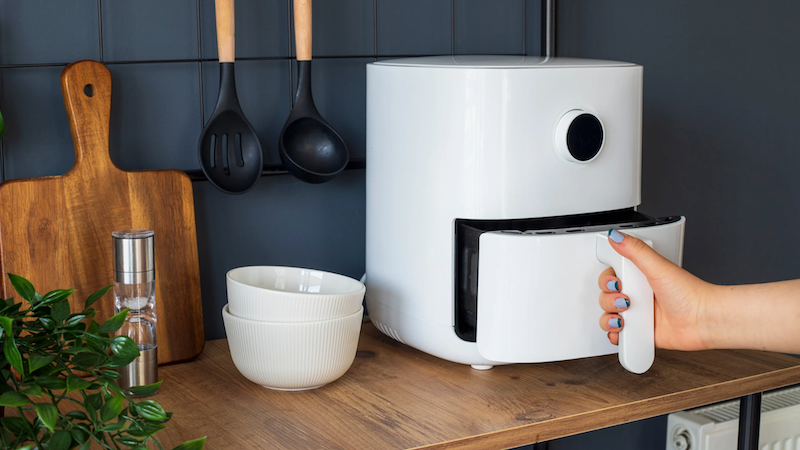Tired of always having to maintain your professional fryer because of the residues or bad smells it gives off? Need a new cooker to help you keep your figure with fat-free meals? Now is certainly the time to opt for an air fryer.
In the world of electrical appliances, air fryers have become “must-haves” in modern kitchens. They even replace electric fryers thanks to their many specific features. If this is the first time you’ve discovered this original concept of preparing French fries without cooking oil, this guide is for you. It takes you on a journey of discovery through the oil-free fryer, exploring its origins and how it works.
Back to the origins of the air fryer
Want to know when the air fryer was invented and, more importantly, who invented the air fryer? Let’s start with the genesis.
The history of this accessory has its roots in the work of Dutch inventor Fred van der Weij, who died at the age of 61 in 2020. Specifically, he became the inventor of the air fryer in 2006 after three years of intensive research. It should also be pointed out that he owed this invention to his passion for cooking. Fred van der Weij was originally looking for a healthier alternative to traditional frying.
He soon devoted his time to developing a revolutionary culinary technology. With the air fryer, his objective was quite clear: to cook perfect French fries while reducing the use of fat. The work was subsequently protected by a patent on Rapid Air technology.
However, it wasn’t until 2010 that the Dutch Philips group of companies officially presented Van Der Weij’s home appliances to the world. For those who have heard of the event, the ceremony occurred at the International Consumer Electronics Fair (IFA) in Berlin. It drew attention to an innovation that marked a real turning point in the history of the modern kitchen.
That’s why the term “Philips Air fryer” is often used and widely recognized in the consumer market. The brand’s involvement played a crucial role in popularizing and marketing the product on a global scale.
A word of clarification:
At the same time, it’s important to note that the history of the air fryer should not be confused with that of other similar kitchen appliances. Indeed, 2006 also saw the arrival of a hot-air fryer developed by the French company Seb: the Actifry. The principles are similar, but the patent technologies and definitions differ.
What is an air fryer?
Also known as a hot-air fryer, the air fryer is a new kind of fryer or a new way of frying.
It’s the opposite of an electric fryer, as it works without oil. In other words, there’s no need to dip your potatoes in hot or boiling oil to crisp them up. The appliance is designed to cook meats and French fries crispy and tender. And if, like thousands of people, you’re wondering whether air fryer cooking is good for your health, the answer is yes.
In a nutshell, the air fryer is a pressure cooker that helps fry food more healthily without compromising taste or texture. Technically, it can reduce fat by up to 75%.
But what does it look like?
Visually, the air fryer is a small, compact, and elegant appliance. Depending on the model, you’ll find it either rectangular or round, with a removable cooking basket inside. On top, you’ll find a simple control panel. It is generally equipped with a touch screen to facilitate the following operations:
- Temperature setting;
- Cooking time;
- Automatic shut-off
- Control programs, etc.
On the other hand, the back of the appliance reveals an internal fan that plays an essential role in its operation. Let’s take a look at this long-awaited part.
How does an air fryer work?
Because it’s a unique device, the air fryer operates according to a well-defined principle that can be summed up in three stages. For the more inquisitive, these include heating, ventilation, and cooking.
Heating operation
When you switch on your air fryer and set it to a particular temperature, the heating element comes into play. More precisely, it’s an internal component that automatically generates intense heat. This rotating heat is similar to that of a built-in oven.
If you want to know how to use an air fryer, the answer is quite simple. Simply adjust the temperature between 80°C and 200°C. Not sure which number is right? Precise results can be obtained by consulting the instructions on the frying product’s packaging. Better still, some models of hot-air fryers come with adjustable thermostats specially pre-programmed for certain dishes.
Fan-driven operation
While the heating element is at work, the fan at the rear of the small appliance kicks in. It draws in hot air and propels it at high speed through the entire system. This, in turn, creates a constant flow of hot air that envelops the food from all sides. Naturally, these preparations have already been placed in the cooking basket.
Cooking operation
The role of hot air comes into its own here. Here’s an example to help you understand:
If you’re cooking fresh or frozen French fries, hot air will act on the outer surface of the fries. Technically, it absorbs moisture and evaporates surface water. As a result, it creates a dry environment that favors the crisping process. At the same time, heat penetrates the interior of the food to cook it evenly from the inside out.
At the end of cooking, the result is potatoes or apples that are both crisp and golden on the outside. Most impressive of all, however, is that they remain soft and juicy on the inside, just as if they had been fried in an oil bath.

